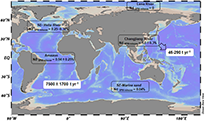** Progress in Earth and Planetary Science is the official journal of the Japan Geoscience Union, published in collaboration with its 50 society members.
Gallery View of PEPS Articles
Research
Biogeosciences
202204202204
Refining the contribution of riverine particulate release to the global marine Nd budget
Hong Che, Jing Zhang, Qian Liu, Huijun He, Zhi-Qi Zhao
Particulate release, Nd budget, Rare earth elements, Changjiang estuary
Fig.1. Distribution of dissolved Nd in surface water along the Changjiang Estuary, removal in low-salinity areas and the release of suspended materials in mid-and high-salinity areas
Fig.2. NdSPM release rate in the different estuaries and dissolved NdSPM flux to the ocean
The release of neodymium (Nd) from particles along continental margins may contribute to losses in the global of Nd budget. The Changjiang River, which carries a heavy load of total suspended matter, empties into the East China Sea, and a strong particulate–seawater interaction process occurs along the salinity gradient. In the low-salinity region (S < 2.0), strong removal of dissolved rare earth elements (dREEs) occurs, but the Nd isotope values are uniform. At mid- and high-salinity (S = 2.0–28.0 and S > 28.0) areas, the dREE concentrations increase slightly. An Nd isotope mass balance indicates that the release of particulate matter is a source of dREEs in the Changjiang estuary. The release rate of particulate Nd (NdSPM) to the dissolved Nd pool in Changjiang estuary is higher than other estuaries, such as Amazon estuary. Composite all river data available from the previous studies indicate that 5800–9200 Mg per year of Nd is released to global marine waters from riverine particles. This estimated quantity is on the same order of magnitude as the calculated global Nd release flux based on the case study in the Amazon estuary. Our study indicates that to better constrain the global Nd budget, it is required to consider the release rate of NdSPM in different rivers due to the significant difference among various rivers, but with very limited available data as of now.







